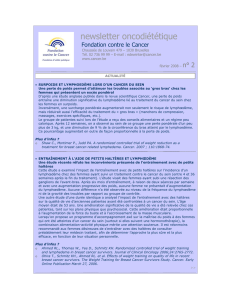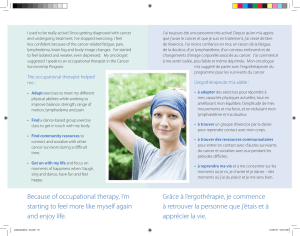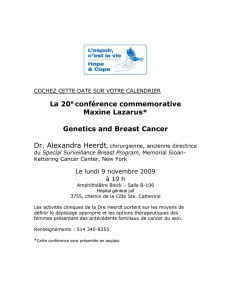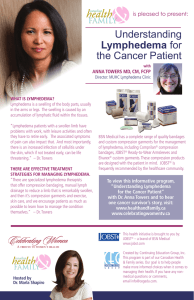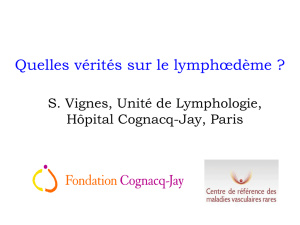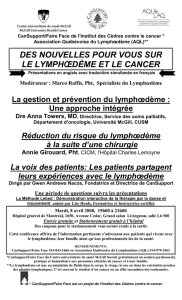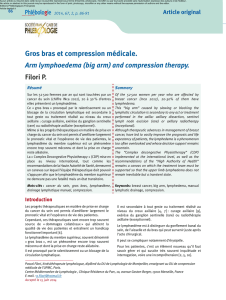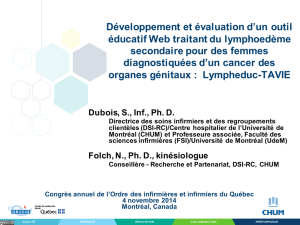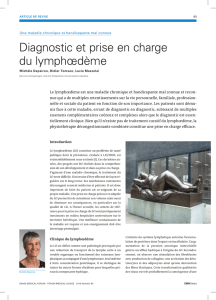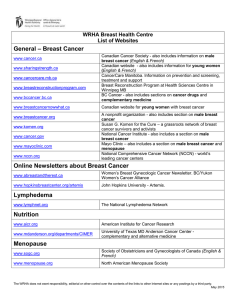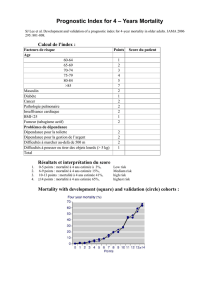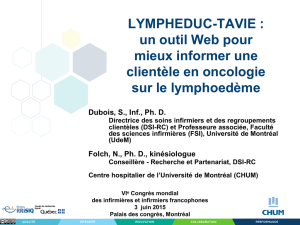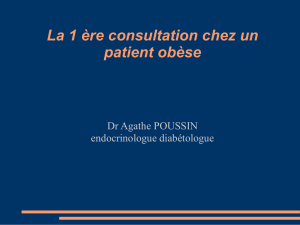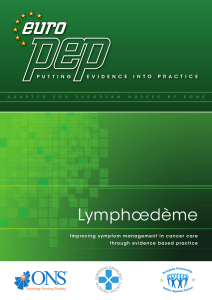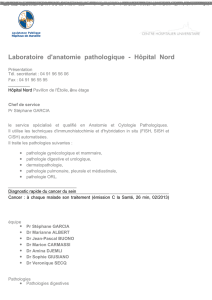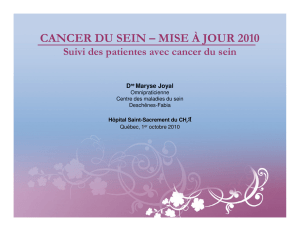Structure et physiologie du système lymphatique
publicité
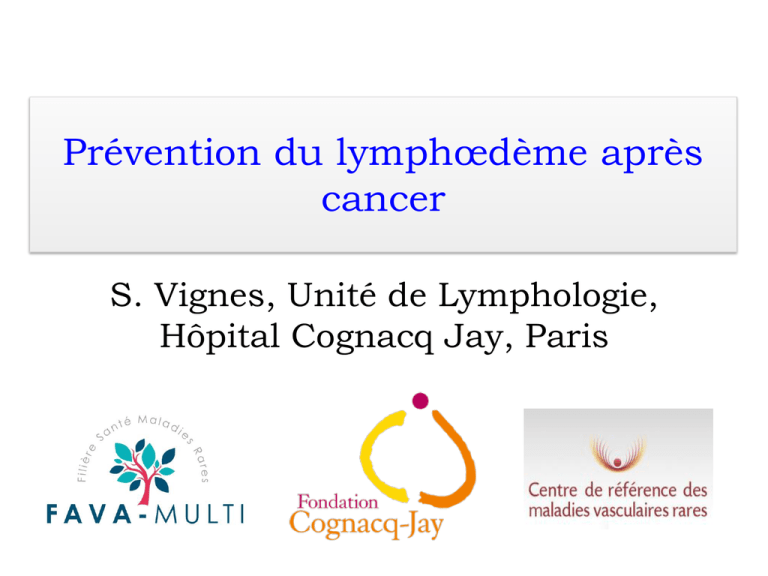
Prévention du lymphœdème après cancer S. Vignes, Unité de Lymphologie, Hôpital Cognacq Jay, Paris Conflit d’intérêt: aucun Pourquoi une femme a un lymphœdème après cancer du sein ? • Curage axillaire : 15% vs 6-8% pour le ganglion sentinelle • Radiothérapie même ne comprenant pas le creux axillaire • Obésité lors du cancer du sein (IMC > 30 kg/m2), risque ≈ 4 • Mais les conseils classiques de prévention (TA, piqûres…) ? DiSipio T et al. Lancet 2013;14:500 Ridner SH et al. Support Care Cancer 2011;19:853 Published in final edited form as: NIH-PA Author Manuscript Department ofBreast Physical and Occupational Massachusetts General Hospital, Boston, Cancer Res Treat. 2013 November ; Therapy, 142(1): . doi:10.1007/s10549-013-2715-7. A bstract Impact of Body Mass Index and Weight Fluctuation on Lymphedema Jammallo et al. Risk in Patients Treated for Breast Cancer Background—Identifying risk factors for lymphedema in patients treated for breast cancer has 1, Cynthia L. Miller, B.S. 1, Marybeth Singer, M.S., A.N.P.-B.C., Lauren S. Jammallo, B.S.given become increasingly important the current lack of standardization surrounding diagnosis and A.O.C.N., A.C.H.P.N.2, Nora K. Horick, M.S. 3, Melissa N. Skolny, M.S.H.A. 1, Michelle C. 5, and Alphonse treatment. Specht, ReportsM.D. on4the association of M.P.H., body mass index (BMI) and weight changeM.D., with , Jean O'Toole, P.T., C.L.T.-L.A.N.A. G. Taghian, Table 3 1 Ph.D. lymphedema risk are conflicting. We sought to examine the impact of pre-operative BMI and 1Department of Radiation Oncology, Massachusetts General Hospital, Boston, MA Multivariate resultschange for association of demographic and treatment factors with risk of lymphedema post-treatment weight on the incidence of lymphedema. 2Cancer Center, Tufts Medical Center, Boston, MA development (RVC≥10%). NIH-PA Author Manuscript Methods—From 2005-2011, 787 newly-diagnosed breast cancer patients underwent prospective 3Biostatistics Center, Massachusetts General Hospital, Boston, MA Variable HR Lower CL P-value arm volume measurements with a Perometer pre- and post-operatively. BMICLwasUpper calculated from 4Division of Surgical Oncology, Massachusetts General Hospital, Boston, MA same-day weight and height measurements. Lymphedema was defined as1.98 a relative10.1 volume0.0003 ALND (vs. SLNB) 4.47 5Department of Physical and Occupational Therapy, Massachusetts General Hospital, Boston, changeBMI≥30 (RVC) ≥10%. Univariate and multivariate Cox proportional hazards models used MA(vs.of 25−<30) 2.46 1.22 4.99 were0.012 to evaluate the association between lymphedema risk and pre-operative BMI, weight change, and BMI≥30 (vs. <25) 3.58 1.66 7.70 0.001 Abstract other demographic and treatment factors. RLNR (vs. breast/chest wall only/none) 2.67 1.25 5.70 0.011 Background—Identifying risk factors for lymphedema in patients treated for breast cancer has Results—By multivariate a pre-operative BMI ≥30 was significantly associated with an Cumulativebecome absoluteincreasingly fluctuationanalysis, inimportant weight from pre-op (1 lb/molack change in weight) 1.07 1.04diagnosis 1.11 <0.001 given the current of standardization surrounding and Reports on the association of body mass index (BMI)BMI and weight change with increased risk treatment. oflymph lymphedema compared tolymph a pre-operative <25 andRLNR 25-<30 (p = 0.001 and p ALND axillary node dissection, SLNB sentinel node biopsy, BMI body mass index, regional lymphedema risk are conflicting. We sought to examine the impact of pre-operative BMI and lymph node radiation = 0.012, respectively). Patients withona the pre-operative BMI 25-<30 were not at an increased risk of post-treatment weight change incidence of lymphedema. lymphedema compared to patients a pre-operative (p=underwent 0.409).prospective Furthermore, large Methods—From 2005-2011,with 787 newly-diagnosed breastBMI<25 cancer patients post-operativearm fluctuations in weight, whether they reflected weightfrom gain or loss (i.e. volume measurements with aregardless Perometer pre-of and post-operatively. BMI was calculated same-day weight and height measurements. was defined as a relative 10 pounds gained/lost per month), resulted in Lymphedema a significantly increased riskvolume of lymphedema (HR: change (RVC) of ≥10%. Univariate and multivariate Cox proportional hazards models were used 1.97, p = <0.0001). pounds ≈ lymphedema 4.5 kg risk and pre-operative BMI, weight change, and to evaluate 10 the association between other demographic and treatment factors. Conclusions—Pre-operative BMI of ≥30 is an independent risk factor for lymphedema, whereas Pag Peut-on prévenir le lymphœdème ? • Ganglion sentinelle – diminuer la fréquence du lymphœdème : 2,5-8% – recherche du ganglion sentinelle du bras (« sentibras ») éviter son ablation lors du curage axillaire diminuer ainsi le risque de lymphœdème • Injection de bleu patenté face postérieure bras, 1er et 2ème espace interdigital • Repérage axillaire : éviter l’ablation de ce ganglion (nég. même si curage +) • Disparition complète de la coloration bleue en 2 ans (50%), légère non gênante (50%) PLoS One 2016;11(2):e0150285 • Identification du ganglion sentinelle du MS lors des curages: 83% • LO : 4,1% Microsurgery 2014;34:421-4 ALV « préventives » même temps chirurgical que le traitement du cancer Microsurgery 2014;34:421-4 Lymphœdème à 1 an : 4% 1. Etude prospective (cohorte PAL : Physical Activity Lymphedema) 2. Questionnaire sur 30 items (FDR potentiels) à 3, 6 et 12 mois 3. LO défini > 5% (volumétrie à eau) à 3, 6 et 12 mois 1955 1962 1998 2006 2009 2010 2005 Ann Surg 2015 • Reconstruction mammaire immédiate (RMI) après mastectomie • Suivi médian : 22 mois • RMI : – expandeur puis prothèse – prothèse en un seul temps – lambeau autologue (transverse rectus abdominis myocutaneous : TRAM, deep inferior epigastric artery perforator : DIEP). Reconstruction mammaire immédiate LO à 2 ans • Global :10,5% • RMI : 5,1% • Sans reconstruction : 26,7% • Prothèse : 4% • Lambeaux autologues : 9,9% Reconstruction mammaire immédiate • RMI: utile pour risque LO après traitement d’un cancer du sein même cancer invasif • Bénéfice RMI avec implants et non lambeaux autologues • Hypothèse « classique » : apport de tissus sains pour améliorer la circulation lymphatique, ischémie locale par l’expandeur : favoriser la néolymphangiogénèse… • Importance de la détection précoce d’un LO – bio-impédancemétrie (courant de faible intensité) – mesure de la constante tissulaire di-électrique (signal de 300 MHz) – clinique par auto-diagnostic (éducation du patient) Conséquences Prise en charge précoce • Jamais de DLM en première intention • Compression élastique • Voire bandages peu élastiques : réduction LO débutant training group reportedPublication pain moreoften at threemonthsand six monthscompared toCastro-Sanchez thecontrol group. HRQoL ported. In 2011,Onestudy Torres 2010reported and Zimmermann statusand date: New, published in Issue2, 2015. Effects of interventions 2012 no explicit distinction wasmadeand reported numberswere and found no significantReview differencebetween thegroups. content assess ed asup-to-date: 23 May 2013. Conservative interventions for preventing clinically detectable See: Summary of findings for the main comparison Early treated ascumulative incidence. Patient education,physiotherapy monitoringand eSarlyinte rvefor ntion including MLD patients at riskMR, forin secondary Due towho substantial and statistical heterogeneity for upper-limb lymphoedema patients areclinical at risk of Bossuyt Citation: tuiver MM, ten Tusscher Agasi-Idenburg CS, LucasC, Aaronson NK, PMM.both Conservativein upper limb lymphoedemaafter breast cancer treatment; Summary short-term (lessthan 6 months) and medium-term (more than 6 preventing clinically detectableupper-limb lymphoedemain patientswho are atof risk of developing lymphoedema afte One study investigated the 2effects a lymphoedema comprehensive outpatient follow-up programme, patient education, developing after cancer therapy of findings Early of shoulder mobilising exercises compared tobreast months, less thanconsisting 24 months) follow-up, (I² = 86%, P =exercise, 0.008; therapy. CochraneDatabas eof S ys te maticRe vie ws2015, Issue2. Art. No.: CD009765. DOI: 10.1002/14651858.CD00 delayed shoulder mobilising exercisesfor patient surgically treated monitoring of lymphoedemasymptomsand early intervention for lymphoedema, education alone.forLymphoedemainciand I² compared = 84%, P <to0.001 respectively RR; and I² = 84%, (Review) forthecomprehensiveoutpatient breast cancer; Summary of findings 3 Progressive resistance any P =timepoint) 0.01 for thecompared HR), no meta-analyses performed. The dencewaslower in follow-up programme(at to educationwere alone(65 people). exercisefor patientsat risk for secondary upper limblymphoedema results of all studies comparing physiotherapy with MLD to any Copyright © 2015 TheCochraneCollaboration. Published Wiley & Sons,compared Ltd. Participantsin theoutpatient follow-up programmehad asignificantly faster recoveryby of John shoulder abduction totheeducation after breast cancer treatment other intervention aresummarized in a single forest plot without alonegroup. Stuiver MM, ten Tusscher MR, Agasi-Idenburg CS, LucasC, Aaronson BossuytAnalysis1.2; PMM Figure4 (Analysis totals(see: Figure3 NK, (Analysis1.1); Authors’ conclusions Manual lymph drainage (MLD) 1.3)), and anarrativesummary of theresultsisprovided below. A summary outcomes of these studies is also provided A B of S the T Rmain AC T in ’Summary of findings ’ table1. draw firm conclusions about theeffectivenessof interventionscontaining MLD. Based on thecurrent available evidence, wecannot Background Theevidencedoesnot indicateahigher risk of lymphoedemawhen startingshoulder-mobilising exercisesearly after surgery compared Figure 3. Forest plotlymphoedemacan ofShoulder comparison: 1 beadebilitating Early physiotherapy MLD vs no early physiotherapy or e interventions for preventing detectable to adelayed start (i.e.clinically seven daysafter surgery). mobility (that is, laterallong-term armincluding movementsand forward flexion) isbetter in the Breast cancer-related sequelaof breast cancer treatment. Several studiesha physiotherapy without MLD, outcome: 1.1 T ime to event for lymphoedema. b lymphoedema in patients whotheeffectivenessof are at risk of differentcompared treatmenttostrategiesto reducetherisk of breast cancer-related lymphoedema. short term when starting shoulder exercisesearlier later. Theevidencesuggeststhat progressiveresistanceexercisetherapy ng lymphoedema after breast cancer therapy doesnot increasetherisk of developing lymphoedema, provided that symptomsareclosely monitored and adequately treated if they Objectives (Review) occur. To assesstheeffectsof conservative (non-surgical and non-pharmacological) interventions for preventing clinically-det Given the degree of heterogeneity encountered, limitedcancer precision, and the risk of biasacross theincluded studies, theresultsof this Tusscher MR, Agasi-Idenburg CS, LucasC, Aaronson Bossuyt PMM limbNK, lymphoedemaafter breast treatment. review should beinterpreted with caution. Search methods WesearchedtheCochraneBreast Cancer Group’s(CBCG) SpecialisedRegister, CENTRAL, MEDLINE, EMBASE, CIN Figure 4. theWorld Forest plotHealth of comparison: 1 Early physiotherapy including MLD vsTrialsRegistry no early physiotherapy (WHO) International Clinical Platformorin May 2013. P L A I N L A N GPsycINFO, U A G E and S physiotherapy UMMAR Y Organization without MLD, outcome: 1.3 Lymphoedema - medium term follow up. of included trialsand other systematic reviewsweresearched. Conservative interventionsfor preventing clinically detectable upper-limb lymphoedema in patients who are at risk of developing lymphoedema after breast cancer therapy (Review) Selection criteria Copyright © 2015 The Cochrane Collaboration. Published by John W iley & Sons, Ltd. 2 Randomised controlled trialsthat reported lymphoedemaastheprimary outcomeand compared any conservativeinterve no intervention or to another conservativeintervention. Data collection and analysis Threeauthorsindependently assessed therisk of biasand extracted data. Outcomemeasuresincluded lymphoedema, in of motion of theshoulder, psychosocial morbidity, level of and functioning activitiesof daily life(ADL), and healthThisisareprint of aCochranereview, preparedpain, and maintained by TheCochraneCollaboration published in in TheCochraneLibrary 2015, Issueof2 life(HRQoL). Wherepossible, meta-analyseswereperformed. Risk ratio (RRs) or hazard ratio (HRs) werereported fo http://www.thecochranelibrary.com outcomesor lymphoedemaincidence, and mean differences(MDs) for rangeof motion and patient-reported outcome Et si le lymphœdème après cancer du sein avait une composante génétique ? • Diagnostic de lymphœdème par impédancemétrie • 110 femmes avec LO, 297 sans LO • Analyse en aveugle du polymorphisme de différents gènes Gènes étudiés • • • • • • • • • • • Angiopoeitin-2 (ANGPT2) Elastin microfibril interfacer (EMI-LIN1) FOXC2, PROX1, LYVE1 Hepatocyte growth factor (HGF), lymphocyte cytosolic protein 2 (LCP2) Hepatocyte growth factor receptor (MET) Neuropilin-2 (NRP2) ROR orphan receptor C (RORC) SpSRY-box 17 (SOX17) Protein tyrosine kinase (SYK) Vascular cell adhesion molecule 1 (VCAM1) Vascular endothelial growth factor-B (VEGFB), -C (VEGFC), -D (VEGFD), receptor 2 (VEGFR2), -receptor 3 (VEGFR3) 81 vs 71% 44 vs 60% 75 vs 85% Et gène FOXC2 61 vs 72% • 120 femmes : 98 sans et 22 avec lymphœdème (apparu 6-18 mois après la chirurgie) • Etude polymorphisme de plusieurs gènes candidats • Résultats : VEGFR3, VEGFR2 et RORC (Retinoic acid receptor-related Orphan Receptor gamma) => organogénèse lymphoïde, lymphangiogénèse Conclusion 1. Nouvelles pistes de prévention – chirurgicales (RMI) – préventives 2. Changements des conseils données aux femmes après cancers du sein (poids, activités physiques) 3. Dépistage précoce LO et compression élastique en première intention 4. Prédisposition génétique…
